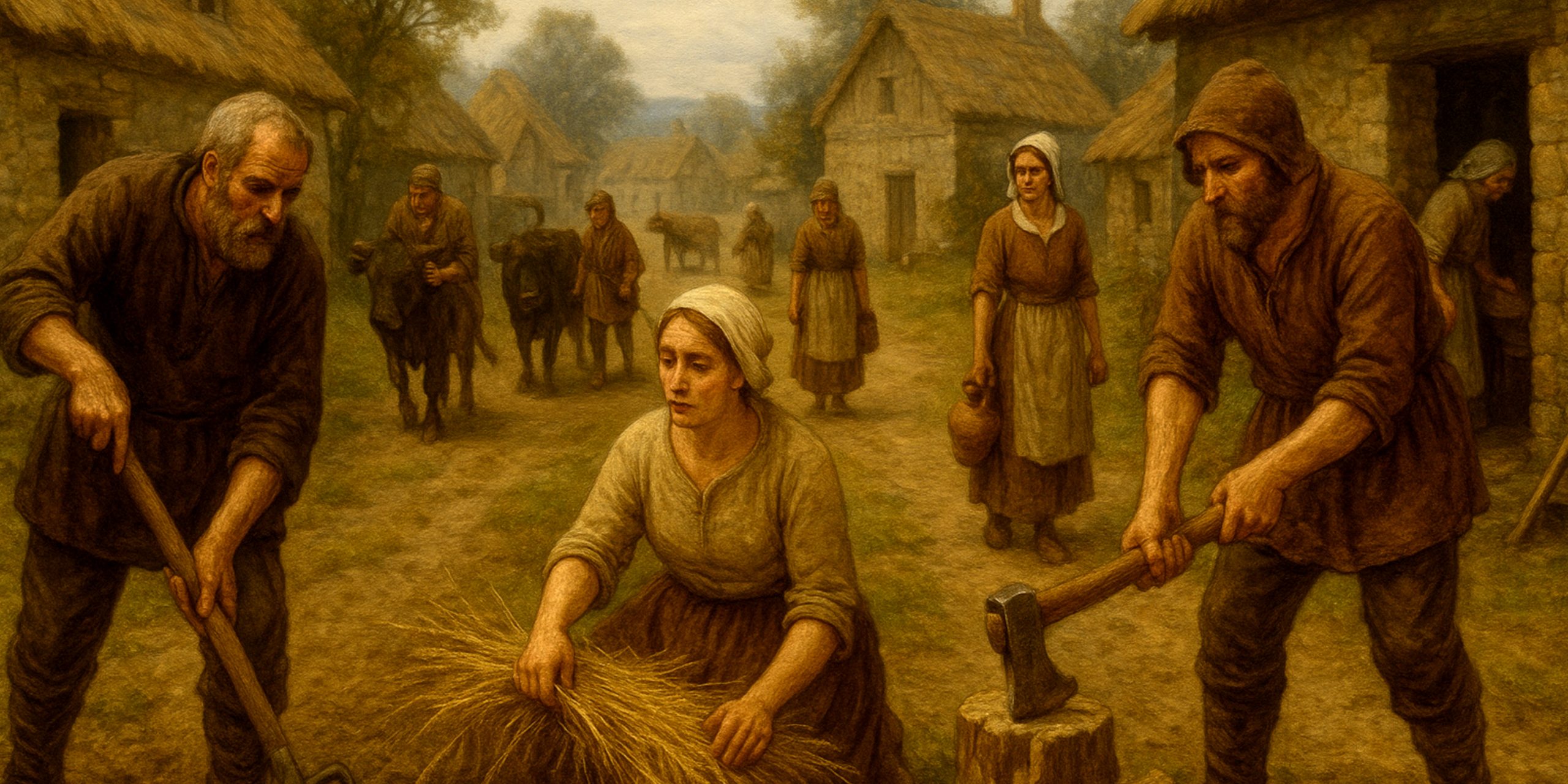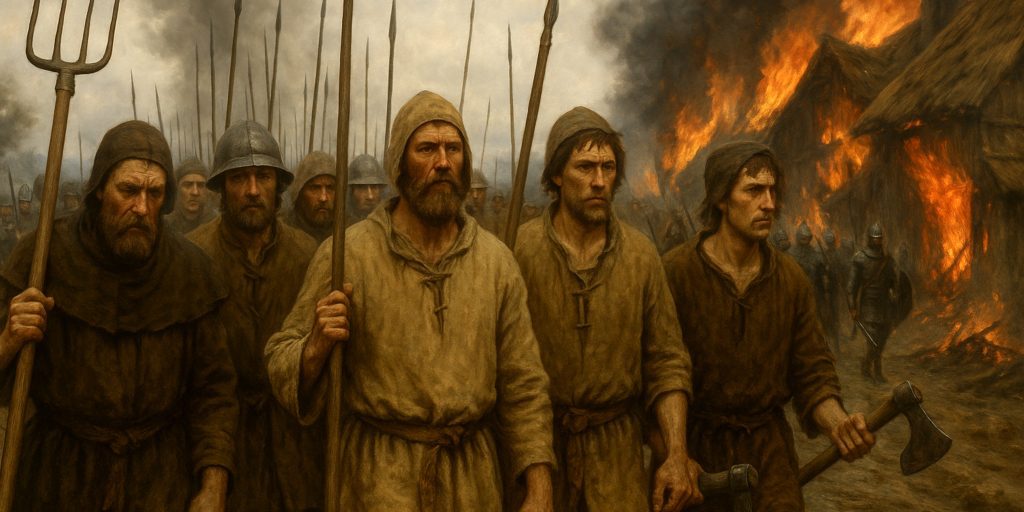
When we think of the Middle Ages, images of knights, castles, and grand feasts often dominate. Yet for the vast majority of people, life looked very different. Peasants made up around 90 percent of the medieval population, living lives defined by toil, tradition, and the occasional touch of humour. Their world was one of mud, sweat, faith, and resilience.
Daily Life and Labour
For most peasants, life revolved around the rhythm of the seasons. Spring brought ploughing and sowing, summer meant harvest and haymaking, autumn demanded repairs and preparations for winter, and winter itself offered little rest beyond mending tools and tending livestock.
- Workload: The average peasant worked from sunrise to sunset, often six days a week. Sunday was for church and rest, though “rest” was relative when you still had animals to feed.
- Land and Lords: Most peasants were serfs tied to the land, obliged to work their lord’s fields a set number of days each week. In return, they could farm small strips for their own survival. The system was rigid, but it worked, most of the time.
- Tools of the Trade: Wooden ploughs, sickles, and oxen were the backbone of medieval agriculture. Iron tools were precious and often repaired to the point of absurdity.
If you imagine medieval farming as a bucolic countryside scene, think again. It was back-breaking, muddy, and utterly essential.
Homes and Family Life
A peasant’s home was functional, not comfortable. Cottages were built of wattle and daub, with thatched roofs and packed-earth floors that often housed both people and animals under one roof for warmth.
- Furnishings: Furniture was sparse, typically a bench, a stool, and maybe a chest. Straw beds were changed infrequently, and the smell would make any modern visitor weep.
- Diet: Bread, pottage (a stew of vegetables and grains), and the occasional bit of bacon or cheese made up most meals. Ale was the safest thing to drink, since the water could kill you faster than starvation.
- Family and Community: Large families were practical, not sentimental. More children meant more hands for work and better odds of survival. Villages were tight-knit communities where everyone knew your business, often before you did.
Faith and the Church
Religion structured every part of peasant life. The Church offered hope and order, even as it collected tithes that took a tenth of every harvest. Holy days provided rare breaks from labour, Christmas, Easter, and dozens of saints’ days were as much about ale and dancing as devotion.
Priests might remind the poor of their place in God’s plan, but for many peasants, faith was less about theology and more about getting through another day without divine punishment or their roof collapsing.
Feasts, Fairs, and Fun
Despite their hard lives, peasants did know how to have a good time. Village fairs, religious festivals, and harvest feasts were opportunities to drink, dance, and occasionally brawl.
- Music and Games: Simple flutes, drums, and fiddles provided music. Games ranged from wrestling to early forms of football that would horrify any referee.
- Clothing: Everyday garments were made of rough wool or linen, but on feast days, peasants might wear their best tunic or a borrowed belt and feel briefly noble.
Humour thrived even in hardship. Peasants told jokes about priests, mocked their lords behind their backs, and found laughter in misfortune, an excellent medieval coping mechanism.
Law, Justice, and Rebellion
Justice was local and often brutal. Petty crimes could lead to public humiliation or worse. The village stocks were a common sight, and gossip was as potent as punishment.
However, peasants were not passive. They protested unfair taxes, mistreatment, and war levies. The Peasants’ Revolt of 1381 in England showed that even those bound by serfdom could rise up when pushed too far. The rebellion failed, but it left a mark on history, and on the nobles’ nerves.
Health and Hardship
Life expectancy was grim. Illness, famine, and poor sanitation were constant threats. Medical care was basic at best, lethal at worst. Herbal remedies and superstition mixed freely. Toothaches, fevers, and childbirth were all matters for prayer as much as medicine.
Yet peasants endured. Their resilience and sheer will to survive formed the backbone of medieval society. Without them, no cathedral would have been built, no lord would have feasted, and no knight would have ridden to glory.
Wars and Armies

For peasants, war was less a matter of glory and more a matter of survival. When kings and nobles quarrelled, it was the peasantry who suffered first and longest. Fields were trampled, livestock seized, and taxes raised to fund yet another “holy cause” that felt anything but holy to those tilling the soil.
The Burden of War
When armies marched, peasants either fled or hid what they could. Soldiers were as likely to loot a friendly village as an enemy one. A poor farmer’s harvest could vanish overnight, feeding an army that left only ashes behind.
- Conscription: Though many peasants were not formally soldiers, they were often pressed into service. Lords might demand local levies, men armed with whatever they could muster, from spears and pitchforks to worn-out axes.
- Supplies and Taxes: Peasants paid for wars in coin and labour. Special war taxes, such as England’s scutage or France’s taille, were levied to fill royal coffers. It was hard to fight for your king’s honour when you could barely feed your own family.
Peasants in Battle
When conscripted, peasant soldiers were typically used for support roles, digging trenches, building fortifications, or hauling supplies. Yet, on occasion, they stood shoulder to shoulder with knights.
- Armaments: A peasant soldier’s arsenal was humble. Spears, bows, and simple wooden shields were most common. Armour was rare and often scavenged from fallen enemies.
- Famous Examples: At battles such as Agincourt and Courtrai, disciplined infantry and archers, many drawn from the lower classes, turned the tide of war. It was one of the few moments where peasants could directly shape history instead of simply enduring it.
The Aftermath of Conflict
The end of a war rarely brought peace to the countryside. Burned crops, ruined homes, and missing sons were the legacy left behind. Entire generations could vanish from the land, leaving villages half-deserted.
For many peasants, war was something inflicted upon them rather than chosen. They became victims, labourers, and occasionally heroes in a game played by kings. When chroniclers wrote of victory and honour, few spared a thought for the ploughman who never came home.
The Seven Swords Takeaway
Peasants of the Middle Ages lived lives of hardship, but also of quiet dignity. They worked the land that fed kingdoms, maintained traditions that outlasted kings, and laid the foundations of modern rural life. Their story is not one of luxury or leisure, but of endurance and humanity.
When we study medieval history, it is easy to be dazzled by crowns and castles. Yet the true story of the Middle Ages lies in the calloused hands and muddy boots of those who ploughed, sowed, and survived.
Watch teh documentary:



